#historic swedish home
Photo


Gorgeous 1928 home in Sweden, 4 bds. and geothermal heating (high-investment/400% efficient) is listed at SEK 10,900,000 starting price - $1.048M.


Pretty 1920s detailed architecture.



Isn’t this beautiful? What a stately room, but there’s a bit of whimsy- notice the plastic lawn goose on the piano.

Pretty dining room.


Love the kitchen redo. You can’t go wrong with Shaker cabinets.

The main bedroom has a separate step-up sitting area. What a lovely place to read or have morning coffee.


It also has this stunning heat stove.


Two other rooms are good sizes and one has a balcony.

Updated bath.

In the basement is a wine cellar.

And, a bright family room.

The new addition on the side of the house looks like a chalet.



Very nice, private space for entertaining.


Sunroom and deck in the new addition.

This is a separate little building at the front of the property- it’s lovely.

Look at how cute the garage is.
https://www.fastighetsbyran.com/sv/sverige/objekt/
268 notes
·
View notes
Text

Old Swedish cottage from the eighteen hundreds
#1800s#history#historic homes#swedish home#Swedish cottage#sweden#Swedish#Swedish history#Scandinavian#scandinavian home#vintage home
1 note
·
View note
Text
This Week on The Nordroom

A Swedish Apartment with a Tiny Terracotta Brown Bedroom

A Stockholm Apartment with Bright Green Color Accents

A Victorian House where the Kitchen is the Heart of the Home

A Classic Stockholm Apartment with Floral Wallpaper

a warm atmosphere in a historic dutch villa

A Light London Maisonette in a Former Artist’s Studio

A Modern Garage Conversion in The Netherlands

A Stylish White deVOL Kitchen in an Edwardian House


Ochre Yellow and Green Tones in a Cozy Welsh Cottage
323 notes
·
View notes
Text






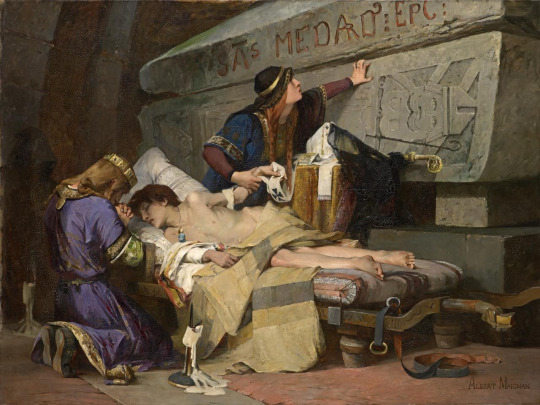
There's something truly magical about late 19th century history paintings.
It's the last gasp of the French Academic style, but instead of lots of drapery and allegory, they are taking cues from the rising tide of archaeological research and forward-looking school of narrative illustration, which adds up to the first real attempts to depict the past as best they it could be imagined. These paintings have more in common with the old-(ish) National Geographic illustrations of life in ancient Knossos than they do with their contemporaries in the Pre-Raphaelite movement.
From top to bottom-
"Cardinal Richelieu at the Siege of La Rochelle," by Henri-Paul Motte (1881)- depicts the siege by the forces of Louis XIII of France, lead by Cardinal Richelieu, against the Huguenots in the port of La Rochelle, 1627-1628
"Bringing Home the Body of King Karl XII of Sweden," by Gustaf Cederstrom (1884)- depicts the route of the Swedish army following a failed invasion of Norway that ended with the death of King Karl XII, 1718
"Zenobia's Last Look on Palmyra," by Herbert Schmalz (1888)- depicts the Palmyrene Queen Septimia Zenobia in the moments before leaving her besieged capitol, having been captured by the forces of the Roman emperor Aureliuan, 272 AD
"Reply of the Zaporozhian Cossacks to Sultan Mehmed," by Ilya Repin (1880s)- depicts the supposedly historical story of the Cossacks sending an insulting reply to an ultimatum from the Sultan of the Ottoman Empire, Mehmed IV, 1676
"The Execution of Lady Jane Grey," by Paul Delaroche (1833)- depicts the execution of the teenaged Lady Jane Grey, who had been elevated to the throne of England and Ireland for (approx) nine days in July of 1553. Her execution was at the Tower of London in February, 1554
"The Cadaver Synod" by Jean-Paul Laurens (1870)- depicts the posthumous trial of Pope Formosus by his eventual successor Pope Stephen VI ten months after Formosus' death, 897
"Chlodobert's Last Moments" by Albert Maignan (1880)- depicts the death of the Merovingian Prince Chlodebert, son of Chilperic I, before the tomb of Saint Medard, where the prince had been brought in the hope of a miracle, 580
542 notes
·
View notes
Text
More than 15,000 people, of whom at least 6,000 were children. That’s how many people Israel has reportedly killed in the Gaza Strip in a matter of weeks – and those numbers are still rising. Israel has bombed basic societal infrastructure and civilian targets such as hospitals, schools, shelters and refugee camps. Israel has imposed a siege, preventing food, medicine, water and fuel from reaching the 2.3 million Palestinians trapped in the occupied Gaza Strip, leading Oxfam to accuse Israel of employing “starvation as a weapon of war”.
Dozens of United Nations experts have described the situation as “a genocide in the making”, hundreds of international scholars have warned of an unfolding genocide and prominent Israeli genocide expert Raz Segal has called it “a textbook case of genocide”. But most of the world, particularly the so-called global north, is looking the other way.
Despite these horrors, some have chosen to focus the public debate on attempts to delegitimise statements about Gaza made by young people in the climate justice movement. Contrary to what many have claimed, Fridays for Future has not “been radicalised” or “become political”. We have always been political, because we have always been a movement for justice. Standing in solidarity with Palestinians and all affected civilians has never been in question for us.
Advocating for climate justice fundamentally comes from a place of caring about people and their human rights. That means speaking up when people suffer, are forced to flee their homes or are killed – regardless of the cause. It is the same reason why we have always held strikes in solidarity with marginalised groups – including those in Sápmi, Kurdistan, Ukraine and many other places – and their struggles for justice against imperialism and oppression. Our solidarity with Palestine is no different, and we refuse to let the public focus shift away from the horrifying human suffering that Palestinians are currently facing.
Due to the amount of misdirected attention on us, as well as the number of misinterpretations of our position, we would like to once again clarify our stance. All Fridays for Future groups are autonomous, and this article represents the views of nobody but FFF Sweden.
The horrific murders of Israeli civilians by Hamas cannot in any way legitimise Israel’s ongoing war crimes. Genocide is not self-defence, nor is it in any way a proportionate response. It also cannot be ignored that this comes within the broader context of Palestinians having lived under suffocating oppression for decades, in what Amnesty International has defined as an apartheid regime. While all of this alone would be reason enough to comment on the situation, as a Swedish movement, we also have a responsibility to speak up due to Swedish military cooperation with Israeli arms companies, which makes Sweden complicit in Israel’s occupation and mass killing.
We are now seeing a sharp increase in antisemitic and Islamophobic statements, actions and hate crimes in Sweden and the world. The leader of the largest member of Sweden’s rightwing governing bloc is speaking of demolishing mosques, and the Israeli flag was burned in front of a synagogue in Malmö. This is unacceptable. We unreservedly condemn all forms of discrimination, including antisemitism and Islamophobia. Everyone speaking out on this crisis has a responsibility to distinguish between Hamas, Muslims and Palestinians; and between the state of Israel, Jewish people and Israelis.
We grieve the lives lost over the past several weeks and are appalled by the fact that those numbers have been allowed to continue to rise. The death rate in the Gaza Strip is at a historic high, with thousands of children killed in just a few weeks. This amount of suffering is incomprehensible and cannot be allowed to continue. When UN experts call upon the world to act to prevent a genocide, as fellow humans, we have a responsibility to speak out.
Demanding an end to this inexcusable violence is a question of basic humanity, and we call on everyone who can to do so. Silence is complicity. You cannot be neutral in an unfolding genocide.
— Greta Thunberg
#politics#greta thunberg#palestine#gaza#israel#genocide#hamas ≠ palestine#war crimes#ceasefire#ceasefire now#never again#never again to anyone#collective punishment#bds#boycott divest sanction#islamophobia#antisemitism#israel is an apartheid state#benjamin netanyahu is a war criminal
74 notes
·
View notes
Text

Swedish Folk Weavings for Marriage, Carriage, and Home 1750 to 1840
Swedish Folk Weavings for Marriage, Carriage, and Home is an exhibition of rare and artful cushions and bed covers woven by women for their households. Many have inscribed dates ranging from 1750 to 1840. Such textiles were used on or displayed for special occasions and were a significant form of decoration for the typical household. The design elements and patterns reflect the influence of centuries of trade since the Viking era. Visitors will see colorful geometric patterns, exotic birds, real and mythical creatures, religious depictions, crowns, floral themes, and even patterns from Roman mosaics.
Courtesy JOZAN
Oriental rug news.

22 notes
·
View notes
Note
For the shipping game: DenEst and SweEst <33
We're off to an amazing start

SweEst

SweEst is one of my favorite ships in the entire fandom. For one, there is lots of historical backing to it - Sweden was once the empire that ruled over Livonia (some of modern day Latvia and all of modern day Estonia) and compared to the other powers that controlled the area, Sweden was pretty relaxed when it came to governing. Sweden was, generally, quite kind to Estonians, advocated for opportunities to have the population educated, and even allowed them to keep their folk beliefs instead of forcing them to convert to Christianity. In the grand scheme of things, a lot of Estonians don't consider Sweden's rule colonization, and it's a generally agreed upon fact that the Swedish Era in Estonia was the good era. Later, Swedes also supported Estonia's bid for independence and around 1000 (I believe) volunteers ditched their country to go fight Russians in Estonia in the 1910s. They remain good friends to this day, diplomatically, too.
In terms of hetalia, I view their relationship as one that's VERY slow to form. Initially, Sweden was uninterested in befriending Estonia, only communicating the fact he was the better option in comparison to the Teutons, Russia, and Denmark. He wanted Eduard to understand that so that he could govern him without hiccups. If Estonia knew he was the best choice, then maybe he wouldn't be as violently resistant to him as he was to everyone else.
I imagine things started to change about 2/3 of the way through the swedish era, when Sweden began to pursue a genuine friendship with Eduard. That was unheard-of (in my hcs) by that point, as Sweden's only real mission was to subdue those his crown told him to, and Estonia would have been one of them. He placed value and worth on nations based on their power, and, of course, being controlled by someone his entire life, Eduard had very little of it. But what he lacked in strength, he made up for in sheer tenacity and power of will, which eventually swooned Sweden, which Sweden wasn't expecting at all. The fact that someone had been able to "seduce" (seduce used lightly here, Eduard was being an asshole and Bernhard just went "omg so dreamy" bc he's AN IDIOT) him and not the other way around really caught him off guard.
He didn't pursue anything, of course. He was too busy, and Eduard was practically a feral cat. Sure, he'd come home to eat, but get too close and he'd run; touch him, and you'll probably contract rabies from the bite. Not only that, but very soon after Ber decided he wanted to kiss this man and stare longingly into his eyes... He lost him. To Russia. And immediately was barred from seeing him. I imagine Russia wouldn't have wanted Sweden, whose rule was very obviously preferred to his by Estonians, to speak to him, lest he inspire a rebellion. The only way they maintained contact was bc Finland decided he cared more about Eduard and his mental health than he did about his hate for Sweden, and he helped smuggle in letters that Sweden wrote. He knew it kept Estonia and Latvia's spirits up.
They probably wouldn't have gotten together until the modern day, if at all. It's honestly equally likely to me that ber is just too afraid to lose Eduard's friendship and keep quiet about his feelings as it is that he took a chance and started a relationship with him.
Either way, Eduard is just COMPLETELY caught off guard. "Me?? ME?? Why!" He doesn't get it. Ber is far more conventionally attractive than Eduard is, plus is tall, with the strong silent schtick that makes people lose it, AND he's a sweet and attentive father who loves and gets along with kids. He's got all these interesting hobbies and interests, and has amazing life stories to tell. Eduard really wouldn't think he's worthy of attention from someone like ber, and that ber is WAY out of his league. It would confuse him, but he obviously wouldn't be opposed to the idea of a relationship with him. He likes ber! He's been friends with the guy since the 16-ish00s. He knows him well. He's seen just how much he's grown as a person. He knows him, his motivations, his interests, and he knows enough to know that he would probably do well in a relationship with him. He's very analytical about the whole thing, because he doesn't want to leap into something just for it to go badly and ruin one of his closest friendships.
I think the relationship would go pretty slowly because of this. For Eduard it's a matter of experimentation and for Ber, it's a matter of keeping Eduard comfortable. He does not wanna step on his toes.
I have a confession to make. I've never offered this ship more than 2 of my brain cells until now. Mostly bc, hot take, I'm not super into Denmark. He's fine! He's silly and cute in an annoying big brother kind of way
DenEst

But this ship almost veers toward "you can see what A likes about B, but not so much what B likes about A."
In my mind, Denmark is immature. Well meaning, yes, but immature. The way I tend to characterize Eduard, is as a very mature person. He had to grow up way too fast because he was constantly being picked on, targeted, and fought over by nations two, three, four times his size. Denmark being one of them, albeit much further back than Sweden and other nations. It was Denmark that Estonia led an uprising against, with the full intention to just kill anyone they caught (St. George's Night Uprising). Denmark wasn't kind to Eduard when he owned his territory and subjugated him. BUT Denmark was stupid and young at this point, fresh out of the Viking era, where violence was how problems were solved. It could easily be said that Denmark learned a lot from his time ruling over Livonia, and it is most definitely true that he chilled out a LOT as time went on.
Denmark can be an idiot. He's impulsive. He's a little absent-minded, and can be over-excitable. But one thing he is not, is malicious. In fact, he's likely the most outwardly kind and affectionate out of the Nordics, excluding Finland. He is soft-hearted and kind, and he cares very much about the people around him.
Some of the ideas a friend (@hetaestoniahq) has shared with me revolve around Eduard in the 90s. If you're unaware, Estonia struggled a lot in the 90s. Being released from a horrific dictatorship that repeatedly tried to demolish your people's spirit in the WORST ways will do that to.
According to his hcs, Denmark was one of the nations who regularly kept contact with, checked on, and spent time with Eduard after he was granted independence. This stems from the fact that Denmark was one of the 1st countries to re-establish diplomatic ties with Estonia, if not the first. Denmark also sent volunteers to aid Estonia in their war of independence, like Sweden and Finland did.
He tried to make sure that Eduard was staying healthy, building healthy habits, and taking care of himself. Obviously this would have been a struggle, but Denmark would have done his absolute best, because Estonia was a friend of his, and he never lets his friends down, if ever he can help it.
And honestly, it would have just gone from there. It's a very soft and wholesome ship, I totally understand why all 5 people who ship this like it as much as they do.
22 notes
·
View notes
Text
Title.
Urgh, how do people normally start this... Fancy greetings? Right, right. Hm...
Afternoon. (That was not fancy at all.)
This is Marshal Louis-Nicolas Davout writing. Or...well, typing.
I've decided to finally excuse myself from my moping session solitude and venture into unknown territory that is this strange platform. (Which I have been...observing from a distance.)
Seeing as my late colleagues have been up to some...shenanigans on this platform, I might as well find something to amuse myself with the ample time I'm given and do some...[*grimaces*]...socialising.
[*sigh*] I'm going to regret this...
So, to whoever may see this and care; you are free to send me your questions, letters, and queries regarding whichever subject you wish. I will be reading through and answering them accordingly when I am not busy tending to domestic matters around the painfully quiet estate.
However, do be mindful of the things you send. Respect goes both ways and I do not like to squabble. Unless it's against certain bastards.
Unsavoury comments regarding my hair will swiftly be ignored and used as fuel for the fireplace.
...Don't expect me to initiate interactions much. Sorry.
Regards,
L Davout.
——————————•
!! This is a joke RP account run by @mbenguin, a guy who is in no way shape or form a bona fide historian-- just really enthusiastic about balding dead nerds and French history! This is in no way meant to be accurate, analytical, or faithful 100% to reality despite being based on actual historical facts to a certain degree. This is a fictionalised parody that is meant to be in-character as possible to my interpretation of the man himself and I'm doing it for shits and giggles !!
Handy list of folks participating in this madness (whose exchanges will be tagged separately!)
Events (chronological, sometimes) ──
[✓ — Finished , ✗ — Ongoing , ` — Alternative timeline (AKA one-shots or something lmfao)]
Birth of "Lenoir", Hell's cutest ink demon chick ✓
Local Old Man Turned Cutest Owl Ever, More On Page 2 ✗
Princess of Eckmühl(?) ✓
⇲ Swedish Home Invasion ✓
⇲ Catgirl Madness (ft. The Ass Boys) ✓
The Ginger Rescue Expedition ✗
⇲ Lenoir took over correspondence!
⇲ Party ADCs in the house tonight ✗
He's back!
Swedish Home Invasion 2 Dinner? ✗
Tags ──
#correspondance de Savigny-sur-Orge -- The marshal's replies to his letters- sent straight from his humble, lonely manor. Could both be written and spoken answers.
#dépêches personnelles -- General responses/exchanges (hilarity ensues)
#proclamations du Prince d'Eckmühl -- Important announcements/event messages
#représentations par le petit gardien -- Drawn visual representation by the marshal's mysterious companion...whose text will be in purple!
#galerie d'oiseaux -- Collection of bird images that 'ruffled his feathers.' With positive connotations.
Be careful when asking questions regarding Aimée or his family!
——————————•
#a wild davout appears!#proclamations du Prince d'Eckmühl#historical rpf#napoleonic rpf#napoleonic shitpost#louis nicolas davout#napoleon's marshals#rp blog#ask blog
30 notes
·
View notes
Note
After seeing your post about Sweden's human name, do you mind explaining what your favorite human names for the other Nordics are and your reasoning?
Especially Norway -- I'm still rather fond of Lukas for familiarity's sake, but would love to have a better alternative! I understand why people don't like Bondevik after a quick search. I've seen people use Thomassen recently and have started using that instead
Sure! I'll also add links to posts made by users from these countries if you need a more reliable source (except Iceland, I haven't seen an Icelandic Hetalian on Tumblr yet).
Norway
If you're looking for infomation about anything relating to Norway, not limited to names but also history, traditions and modern culture, YOU NEED TO TALK TO OUR RESIDENT NORWEGIAN @ifindus. They have done university-level research in Norwegian history and I am constantly learning new things about Norway from their posts, which says a lot as someone who has half his family from Norway. It's thanks to Findus that I learned about a very common misconception about Norwegian names that I will explain below!
Unlike people from English-speaking countries, Danes, Swedes, and Finns, Norwegians do not use "middle names" in the sense of "alternative first names that are mostly ignored except on official documentation". It's very common for creators to give Norway a name like "Lukas Øyvind Haugland" with the idea that he goes by Lukas in daily life, and Øyvind is a mostly unused middle name. But that's not how it works in Norway! Instead, both Lukas and Øyvind will be recognized as his first names of equal priority, and he will be referred to using the double name Lukas Øyvind. Findus can explain this better than I can, but you cannot simply smash two names together to form a Norwegian double name, as many name combinations, such as Lukas Øyvind, sound ridiculous. Paraphrasing Findus' words, there are no definite rules that make certain double names realistic or silly, it's mostly a feeling that the name "sounds good". There are however common patterns, such as the first half having less than or equal syllables to the second, both names having the same "vibe", and not having too many consecutive consonants.
Thanks to Findus' advice, I recently changed my name for Norway to drop the "middle names", cutting it down to Sigurd Fjellanger. Sigurd, an Old Norse name meaning "victorious guardian", is the most popular first name among Norwegian creators because of its uniqueness to Norway and use in all time periods. Fjellanger is my personal choice, as I want a nature name for Norway that refers to his home region. Nature names in Norway often indicate where a person's ancestors were from as they were historically chosen from names of towns and farmland. Fjellanger means "mountain fjord" and is associated with coastal western Norway, which is where my Sigurd's hometown is. Findus uses the last name Nordvik which means "northern bay" and is not associated with a specific region (their Norway moves around the country and does not have a fixed hometown). Patronymics (names ending in -sen) don't have strong regional associations and Thomassen is a common, neutral-sounding name.
It seems like I have unintentionally written a long post again. Other characters under the cut.
Sweden
The other Nordic countries use "middle names", but like in real life, these extra names will never be seen outside of these name posts. My full name for Sweden is Björn Axel Johan Stjernqvist because he's my country and I can make fun of him. Björn is a very Swedish Old Norse name meaning "bear" while Stjernqvist, meaning "star branch", is a lame reference to his Hetalia name that also contains the word "star". 95jezzica is from Sweden and recommends the classic Svensson as his last name, but I personally avoid giving very common names to characters in case I know or will meet someone with that name. I also prefer to choose nature names unless there is a meaningful (parental) connection to the name in the patronymic. Double names are also used in Sweden, but they are much rarer and are associated with the older generation. Swedish double names are connected with a dash rather than a space, like Lars-Erik.
Denmark
My beloved Denmark has the name Søren Mathias Holgersen. Mathias is not an Old Norse name. It originates from Latin and means "gift from God", which is what he is to me. Holgersen is a reference to the legendary Danish hero Holger Danske. Some creators think that the name Mathias is inaccurate for Denmark in all periods, but that's only true for the pre-Christianization era. There are 22,7k people currently named Mathias in Denmark in 2023 (this is not including the alternate spellings). In fact, none of the popular alternative names for Denmark that begin with M, Mikkel and Magnus, are of Old Norse origin either. But that's alright, because Denmark was the most strongly influenced by continental Europe culturally and has the weakest Norse influence out of the Scandinavians. This post by someone-you-do-not-know from Denmark discusses what's wrong with the Hetalia name suggestions for Denmark and offers additional suggestions. The OP has a personal reason for disliking the name Mathias, but the name is otherwise alright to use.
Finland
I unfortunately don't speak Finnish and don't know much about Finnish naming traditions, so I use a name that has been personally recommended by Finns and is quite close to the Hetalia name: Timo Kalevi Väisänen. The middle name Kalevi was randomly mentioned by ask-finny from Finland and I'm not particularly attached to it either, so I'm open to changing it. Nordickies is also from Finland and has made two very helpful posts about analyzing Finland's Hetalia name and resources for researching Finnish names.
Iceland
Iceland has a very strict naming law which could make choosing his name easier or more difficult depending on how you look at it. The first name Emil is permitted on Iceland, but it's a modern trend name that doesn't have an Icelandic history, its use began after the release of Astrid Lindgren's book Emil i Lönneberga. Steilsson is illegal as it would mean that Iceland's father was named Steil, which is not a permitted name (nor did it ever exist in the Nordic countries). Like Finland, I kept his Hetalia initials and gave him the name Eiríkur Stefánsson.
#ask#hetalia#hws denmark#hws sweden#hws norway#hws finland#hws iceland#aph denmark#aph sweden#aph norway#aph finland#aph iceland#character development#the more you know#long post#I just noticed the coincidence of Stjernqvist because names like these were created by smashing two often unrelated words together#but in the modern day Star and Branch are related terms#in the context of Star Branch Clone Fork Pull Request that is#Björn is a software engineer to me and I'm laughing so hard at his tangentially programmer name
91 notes
·
View notes
Photo

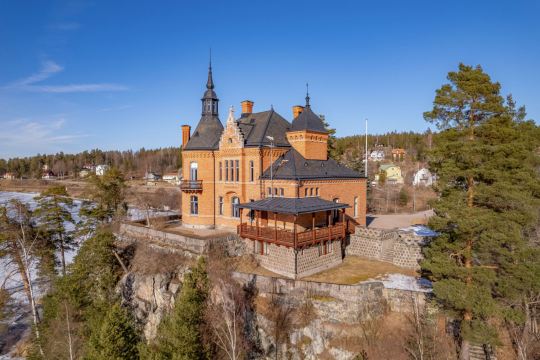
Dreamy historic 1886 villa is a knight's castle in the form of pinnacles and towers, or like a castle in the French countryside. It’s in the village of Ängelsberg, situated in Fagersta Municipality, Västmanland County, Sweden. The villa today is a residence with 5 rooms and a kitchen on the main floor and 6 rooms on the upper floor. And, the price for all of this isn’t bad- $1,354,725.
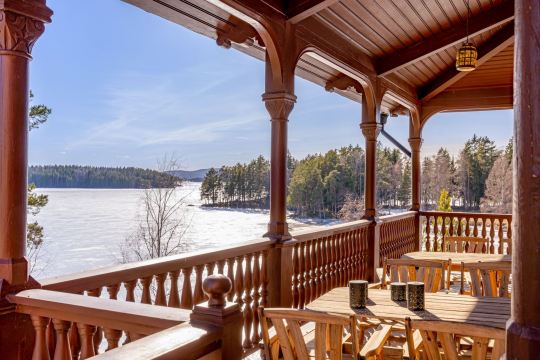
This large terrace has a beautiful view of Lake Åmänningen.

Enter a large foyer and to the right is the main hallway.
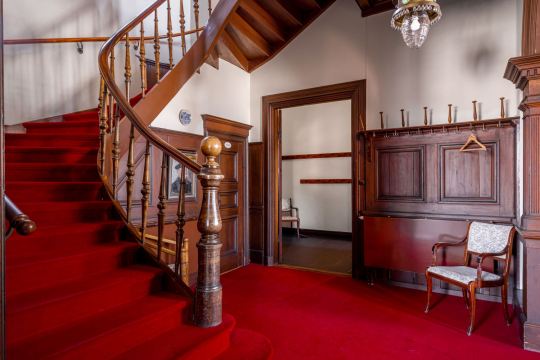

Look at the stunning millwork. The beautiful ground floor level rooms are off the main hall and the sweeping stairs lead to the upper rooms.

Closeup of the details.

Sitting room. Pay particular attention to the beautiful fireplaces in each room.


Isn’t the dining room stunning? The wood is incredible. Look at the details.

A breakfast room or casual dining, but look at it.

Closeup of the ceiling detail. Look at the intricacies of the inlaid wood pattern.


The kitchen is newly reno’d and is a pristine white and black.

This room is set up as a home office, but could also be a bedroom.

Look at the unusual windows in this bd.

All of the bds. are spacious and get natural light.
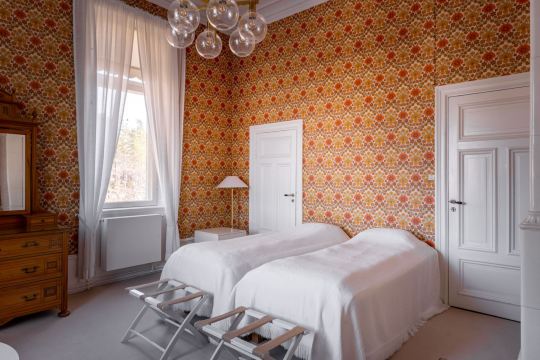
Guest room.


Lovely turret balcony.

It’s winter, but there is a large patio as well as a big covered porch/deck.

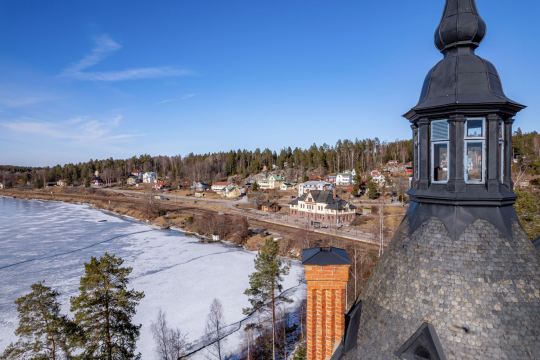
I wonder if you can go into that little tower.

Castle-like cement walls.

Gated entrance.

Plus there’s another residence on the property.

And, a barn with stables.

For you get a $1M elsewhere, this is a buy.
https://rc.se/bostader/obj12549_1974950537/
200 notes
·
View notes
Text
[“All over the world, it is routine for anti-prostitution policing to involve evicting sex workers, prosecuting them, and deporting them. Only in the Nordic countries, however, is this imagined as a feminist achievement.
For Sweden particularly, cleansing the nation of undesirables as a form of social improvement has long been part of national identity. In the early twentieth century, the political theory of folkhemmet (‘the people’s home’) was established to conceptualize the ideal Swedish society and its benevolent welfare state. The basis for this idea is that, like a small family household, Swedish citizens contribute and in turn are benignly looked after by the state, which acts as a ‘good parent’, steering its offspring away from misbehaviour and corruption. Unsurprisingly, the role of the prostitute in folkhemmet is an antagonistic one. Who but a prostitute could more archetypally threaten the family hearth?
Other groups, too, are seen as similarly disruptive to Swedish familial normativity: people who use drugs, people with HIV, transgender people. How this ‘national family’ has historically responded to these groups paints a picture of Swedish control. In the name of folkhemmet’s eugenicist commitment to ‘social hygiene’, 21,000 people were forcibly sterilised before 1975. Ninety per cent of those sterilised were women who were deemed to be ‘inferior, anti-social, dangerously hypersexual … promiscuous or feebleminded’. During the 1990s, the Swedish state incarcerated people living with HIV without trial, some of them for years – ninety per cent were sex workers and drug users.This legacy lives on in Swedish governance. In 2009, a Left Party politician noted that these punitive responses to HIV played a part in the social construction of ‘the nice clean Sweden’. In order to legally reassign their gender, trans people were subject to compulsory sterilisation until 2013. Even the presence of drugs in the body is criminalised. This is a far harsher anti-drug law than any other European country has, which goes some way towards explaining Sweden’s devastating number of drug deaths – the second-worst in Europe.
Ultimately, only Sweden’s ‘ideal’, normative citizens – healthy, productive people of Nordic stock – are those who can be deemed responsible and rational, looking after themselves in a way that is independent but in accord with family rules.”]
molly smith, juno mac, from revolting prostitutes: the fight for sex workers’ rights, 2018
53 notes
·
View notes
Text
This Week on The Nordroom

Pink and Gray Rooms in a Victorian House with a Guest Cottage

A Charming English Cottage Filled with Historic Character

Calm Color Tones in a Light Scandinavian Studio Apartment

Color and Graphic Design in the Home of a Dutch Interior Stylist

A Swedish Family Apartment with a Butter Yellow Kitchen

Belgian and Nordic Influences in a Victorian Terrace by Pascoe Studio
200 notes
·
View notes
Text
- Shared from Facebook -
Tobias Forge (Papa Emeritus) and his significantly respected unique Swedish rock band Ghost chose Cherry Bar to host their End of 2022-2023 World Tour party last night.
I’m told the band leader Tobias himself specifically insisted that this historic Ghost event be hosted at Cherry Bar (a Laneway dive bar in Melbourne with a mere 250 capacity). This never happens. Every other band in the World outsources these admin decisions to their “staff”.
I spoke at length with Tobias last night, one of the biggest “rock stars” on Earth.
He was incredibly impressive. I mean it.
Tobias Forge may be the most humble, respectful, calm and graceful human being I have ever met at Cherry. And I’ve met them all.
With those sparkling blue-green eyes, he’s like Simon the Likable from ‘Get Smart’.
Tobias reflected on his two previous visits to Cherry and commented on how pleased he was that we found a new home when he feared we were closing forever.
My dear Mother knows less about Cherry Bar than this Stockholm resident does!
To be at the end of a grueling world tour and look as healthy and content as Tobias does is beyond unexpected.
It is downright miraculous.
I’m telling you he looked like he’d just returned from a soul cleansing one-month Tibetan retreat.
Every other artist I have seen at this finishing line looked like… they were lucky to make it. I’m just shooting straight here folks.
When I asked Tobias “Mate, what can I get you to drink?”, he responded courteously “May I please have a coffee with milk, if it’s not too much trouble.”
When I returned 5 minutes later with a paper cup with black coffee and a paper cup with milk (from 7/11) it was like I’d just solved the Da Vinci Code. He was genuinely taken aback by this simplest of accommodations. I shit you not. His jaw dropped like I’d just upgraded him to First Class. You can’t fake this.
To top the evening off I was gifted by Tobias and Ghost…. an immaculate framed Gold Record with all the Ghost World Tour details on it. Trust me. It’s special.
What is going on here?!
What the actual fark is going on here?!!
A world-renowned ground-breaking Swedish anthemic rock band (on trajectory to be the biggest band in the world) on the exhausting final days of their expansive World tour… are taking the time out to meaningfully acknowledge and respect tiny Cherry Bar in Melbourne.
It’s a beautiful true story that deserves to be shared.
Share it.
Papa don’t preach.
Papa delivers.
And Cherry respects.
James Young.
JPY (Tonight, you can… Call Me Little Sunshine)
Owner. Booker.
Cherry Bar
Melbourne
That’s me on the left in this photo. 🙂
Tobias on your right.
#just needed to share#our tender father#ghost band#the band ghost#papa emeritus iv#copia#papa iv#tobias forge#Cherry bar#re imperatour
72 notes
·
View notes
Text
Archaeologists in the western Swedish city of Halmstad have unearthed an astonishing relic from the medieval era.
While exploring the Lilla Torg site, known for its rich historical significance, a team from Kulturmiljö Halland and its partners stumbled upon a grave containing a massive, four-foot-long sword next to the remains of an elite man who lived in the late 15th or early 16th century. What's more fascinating? This man was over six feet tall, a rarity for medieval times!
This extraordinary find was made during excavations of a large cemetery beneath the square, once home to a Franciscan monastery and church from 1494 to 1531. The discovery of this long, rusted sword, still bearing its wooden hilt and adorned with two inlaid crosses, speaks volumes about man’s elite status in medieval Scandinavian society.
24 notes
·
View notes
Text
Part 1 I Part 2 I Part 3 I Part 4 I Part 5

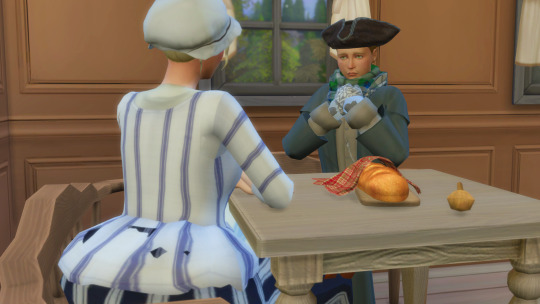
"My God!" Charles Elias said. "That's awful! The poor girl..."
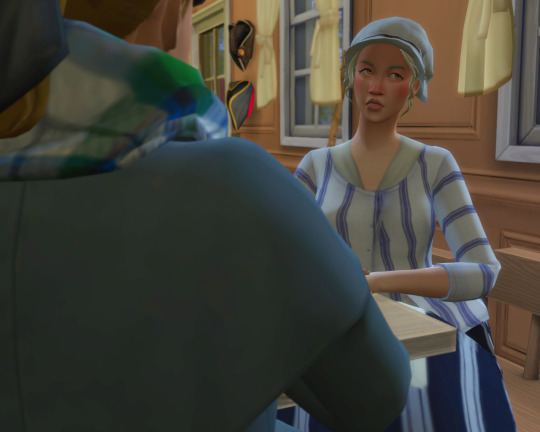
"Oh, yes, yes," the maid said, "Very tragic. But to see a troll! Could you imagine? There's whispers she might be cursed, troll-touched as she is."
"Are you done?" A voice rang out across the kitchen and a bolt of ice ran down Charles Elias' spine.


"Oh, Laura!" The maid said. "This young man here was waiting for you."

"I can see that," Laura said, glaring daggers at the maid, "You didn't think to come fetch me?"
"Oh, no," the maid said, "I was sure you would turn up soon enough. Besides, the poor man ought to know what he's getting himself into, don't you think?"

Laura and the maid both turned to look at Charles Elias at once, and he desperately wished for the floor to open up and swallow him whole.
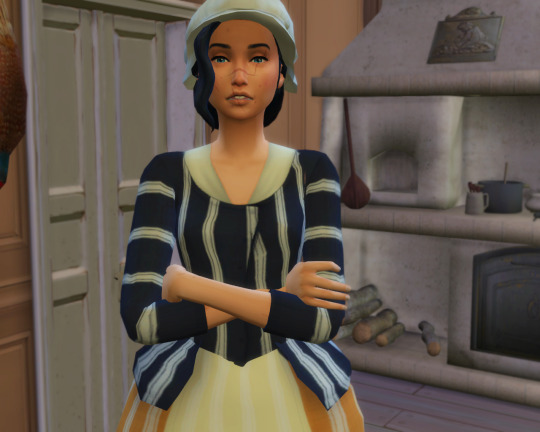
"I see..." Laura said. "So he's a gossip too, then? That's good to know."

"A gossip, hah!" The maid laughed. "He seems perfectly fine to me. Don't you agree, young man?"
"Uh--"
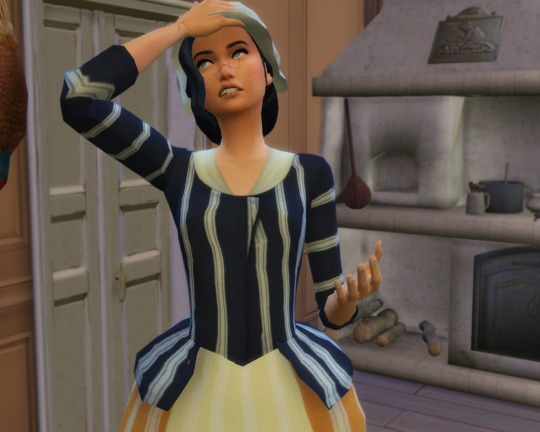
"Oh, forget it!" Laura snapped. "Come on, Mr. Park. We're leaving."
Part 1 I Part 2 I Part 3 I Part 4 I Part 5
Summary of Part 3:
The maid told Charles Elias about an incident in Laura's childhood.
Her and her mother and father had been traveling by wagon back home when their horse startled and the wagon fell off a cliff.
In the aftermath only Laura survived, albeit wounded, and when she was rescued she told people that what had startled their horse had been a troll.
Historical Info
Let's talk about trolls and superstition!
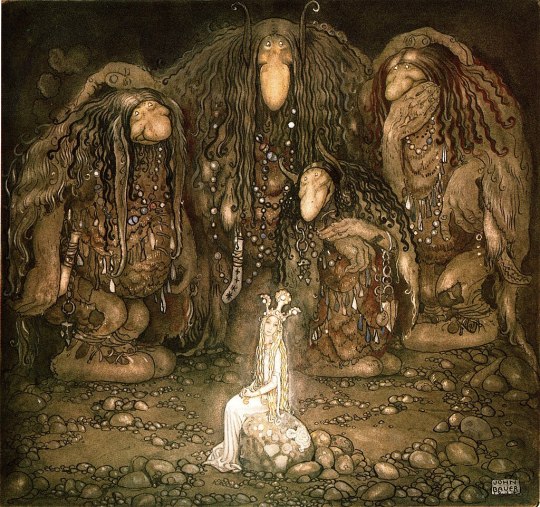
Art by John Bauer (1882 - 1915)
So the troll in Scandinavian folklore/superstition is a creature of the wilderness. There's like a quintillion different troll stories and their appearances and behaviour can be quite varied from place to place, story to story. Sometimes they're hostile, sometimes they're friendly.
Sometimes they're human-like, sometimes they're very not.
In The Genre of Trolls by Camilla Asplund Ingemark, she summaries the varied views of trolls based on location in the following way:
"The Central Swedish trolls dwell in mountains, those in Southern Sweden inhabit mounds, and Norwegian trolls live in the high mountains. The looks of the troll may be pictured in various ways, but its ugliness is a common feature. In Central Sweden the troll can be of human height, whereas the Northern and Western parts of the country favour huge trolls (Hartmann 1936: 60–65)"
Since there's a lot of research that has been done into folklore by smarter minds than me, I won't make any further proclamations on the workings of trolls as a whole. Other than to keep in mind that views and stories were varied and different, but the throughline seems to be that trolls are often to be feared and avoided.
In the story of what happened to Laura's family we have a horrific and traumatising accident attributed to a troll.
Obviously trolls aren't actually real (although Laura and others believe them to be) and so whatever she truly saw was most likely twisted by trauma and injury into something she had heard of in stories.
In my pictures I chose to have the troll look like a mix between a goat and a man, inspired by the following quotes from the previously quoted text:
"The ambiguity between human and animal characteristics is an important one"
&
"One troll from the Åland Islands shows itself as a he-goat with terrible horns and a beard enveloping the entire hill where it lives (SLS 59: 48–49)"
It intentionally looks almost like very typical depictions of the Devil, since after Sweden became Christian "the troll was assimilated into the image of the Devil"
Now you may be wondering why Laura is being treated so poorly when she was simply the victim of a horrible accident (and supposed troll encounter).
Partially this is just basic human cruelty. Laura, for one reason or another, was seen as an acceptable person to mistreat.
It is also a matter of people fearing those who have had encounters with trolls. People surviving a troll encounter can be viewed in a few different ways. Sometimes they are simply victims of unfortunate circumstances, other times they are transgressors who get punished.
Often in the stories mentioned by The Genre of Trolls the people who have encounters with trolls where they survive (relatively) unscathed are in some ways tied to the trolls. Whether it be a troll expecting a future favour or gift, or wishing to re-capture a previous victim.
Sometimes in stories where someone has a non-deadly encounter with a troll they may be gifted a "second sight" of sorts, allowing them to see through troll-made illusions or tricks.
In these cases the people are "trapped between different versions of otherness, first a supranormal otherness, then a socially defined alienness".
In Laura's case she is not quite thought to possess any supernatural abilities, but the people in the village see her as someone who could be at risk of either a repeated troll encounter (which could put others at risk) or someone who could unknowingly owe the troll something since she lived when others didn't.
In essence her being mistreated by others is them seeing her connection to trolls as a sort of 'otherness', and as we all know many people in the past and now don't appreciate those who do not fit in.
#300 years challenge#sims 4 decades#sims 4 legacy#sims 4 historical#olafssons#gen 4#charles elias park#ts4 decades#ts4 historical#ts4 legacy#simblr
24 notes
·
View notes
Text
facts about josefina, kirsten, addy, kit and julie! :D
(from their new pages!)
✿ To learn more about what Josefina’s life would have been like, author Valerie Tripp spent two summers in New Mexico. She visited living history museums and interviewed elderly New Mexican women about the daily lives of Hispanic families and children in rural New Mexico.
The models for Josefina’s home were la El Rancho de las Golondrinas near Santa Fe and Hacienda de los Martinez near Taos, NM. Both are former ranchos from Josefina’s time and now living history museums that you can visit today.
Josefina’s first and last names are drawn from the New Mexican censuses of 1790 and 1823.
American Girl worked closely with the advisory board to decide what Josefina would look like. Board member Felipe Mirabal even cut off a lock of his own hair and sent it to AG to ensure that the Josefina doll’s hair color was just right!
Although Josefina is actually a Mexican citizen, the advisory board felt comfortable calling her an “American girl” because her story presents a history and heritage that’s an integral part of America today.
By the end of her series, Josefina has a new mother. This plot element symbolizes the change for the Spanish settlers of New Mexico and the Southwest, who lost their mother country of Mexico when they became citizens of the United States, their new mother country. ✿
✿ Kirsten was one of the first three characters in The American Girls Collection, along with Samantha and Molly, when Pleasant Company debuted.
The Kirsten doll and accessories were “archived” in 2010 and have only been rereleased once in 2021 and once in 2024 since then.
One of the outfits that was sold for Kirsten was a housecoat and sockor, or wool slippers. The sockor for the Kirsten doll were handmade by a woman in Sweden beginning in 1987 for twenty years.
The original family portrait in Kirsten’s books is made to look like a daguerreotype, which is a type of photograph from the time. Later, the portraits of Kirsten’s family and friends were done individually to match the other American Girl books.
In Pleasant Rowland’s original business plan, Kirsten was named Rebecca, and was a Norwegian immigrant in 1865.
The team who created Kirsten did a lot of research with the Minnesota and Wisconsin Historical Societies, who had a lot of information about the Swedish settlers who came to these states in the 1800s.
Kirsten’s Swedish dirndl and kerchief outfit were first released in 1989. ✿
✿ Addy was the first American Girl doll that came with pierced ears.
The cowrie shell necklace that Addy wears is special, as the cowrie has ritual significance for some West African cultures.
The Addy doll and books debuted in September 1993. She was the fifth historical character and the first Black character.
Pleasant Rowland, the founder of American Girl, reached out to author Connie Porter to write the Addy book series after reading her adult novel All-Bright Court.
To promote the Addy book series, American Girl took author Connie Porter on a 10-city author tour to bookstores, libraries, and schools, reaching an audience of more than 15,000 people.
Researchers on Addy confirmed when the full moon would have been during Addy and her mother’s escape from enslavement in 1864 to ensure historical accuracy in the timing.
The museum program, Addy at Ohio Village, debuted in 1998.
The dialect used in the Addy books was created by author Connie Porter to be a balance between what speech of the time would’ve sounded like and what is accessible for young readers and was reviewed by two dialect experts at Jacksonville State University in Alabama.
Addy was the first American Girl character to have an advisory board. Addy’s advisory board was made up of Black historians, educators, and museum curators who ensured the depiction of Addy’s life and times was historically accurate.
The advisory board for Addy included: Lonnie Bunch, Cheryl Chisholm, Spencer Crew, Violet Harris, Wilma King, June Powell, and Janet Sims-Wood.
Addy’s first three books sold more than a million copies in the year they were released.
Some of the original time periods discussed for American Girl’s first Black character included the Harlem Renaissance and the Civil Rights era, which were used later for Claudie Wells and Melody Ellison, respectively. ✿
✿ Kit Kittredge is the seventh historical character that American Girl created.
When she wrote the Kit books, author Valerie Tripp was inspired by her mother, who was Kit’s age in 1932.
The movie Kit Kittredge: An American Girl was released in 2008 and starred Abigail Breslin as Kit—plus actors Chris O’Donnell, Julia Ormond, Joan Cusack, and Stanley Tucci.
Illustrator Walter Rane used himself as a model for the grumpy grocery store owner in Kit’s stories.
When Kit launched, American Girl held events called Kit’s Share and Care Party where girls were invited to donate canned goods for a food drive.
Like Kit’s dad, author Valerie Tripp’s grandfather paid his staff out of his own pocket as long as he could, but eventually had to close his hotel during the Great Depression.
Kit was the first American Girl character doll with freckles and the first with short hair.
Development on Kit was started before Mattel purchased Pleasant Company (American Girl’s original company name) but she was launched after the purchase.
After the launch of the Kit doll and books, Valerie Tripp received a letter from a woman named Kit Kittredge who had grown up in Cincinnati during the Depression and was very excited about the coincidence!
American Girl’s Claudie Wells, whose stories are set in the 1920s, could have faced the challenges of the Great Depression in her teens and twenties. ✿
✿ When Julie launched, in 2007, American Girl historical characters’ years had always ended in 4, so Julie’s year was set as 1974—even though her stories begin in 1975.
Julie’s stories are set in San Francisco to express the open-minded, progressive spirit of her time. At the forefront of the hippie counterculture, San Francisco’s colorful, creative, free-wheeling vibe strongly influenced the music, fashion, and art of the 1970s.
When Julie debuted, some customers felt American Girl should not depict a girl with divorced parents. But since about 50% of kids today live with divorced parents, the creators of Julie felt it was important to have a character and doll who represented their experience.
Author Megan McDonald has four sisters who inspire many of her stories. Quite a few of the scenes between Julie and her teenage sister Tracy were inspired by Megan’s experience growing up with her sisters.
When she’s running for election to student body president, Julie debates her opponent, a popular sixth-grade boy. The 1976 Ford-Carter election debates inspired author Megan McDonald to come up with this plotline.
When author Megan McDonald was ten, her first published story appeared in her school newspaper. Her story was about a pencil sharpener! ✿
#american girl#josefina montoya#kirsten larson#addy walker#kit kittredge#julie albright#the addy moon fact is just like what i did for the rewrite's rooftop scene! :D#historical accuracy to the extreme! ;)#the last kit fact is more kit adjacent but it makes you think! :o#and that second kirsten fact makes me wonder if this is a special temporary thing... :o#it's best to enjoy it while it lasts! :D
9 notes
·
View notes